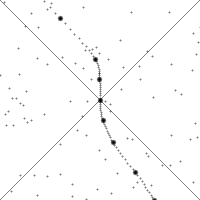[edit] Changing views of spacetime along the world line of a rapidly accelerating observer
In this animation, the vertical direction indicates time and the
horizontal direction indicates distance, the dashed line is the
spacetime trajectory ("world line") of the observer. The lower quarter
of the diagram shows the events that are visible to the user, and the
upper quarter shows the light cone- those that will be able to see the
observer. The small dots are arbitrary events in spacetime.
The slope of the world line (deviation from being vertical) gives
the relative velocity to the observer. Note how the view of spacetime
changes when the observer accelerates.
Compare Image:Galilean transform of world line.gif.
Source of program used to generate image:
//GPL
#include <stdio.h>
#include <stdlib.h>
#include <math.h>
#define PI 3.141592653589793238462
#define SX 200
#define SY 200
#define PL 100
#define DN 2000
unsigned char img[SX][SY];
double path[PL+1][2], dots[DN][2];
void dodot(int x, int y, double f) {
if(x<0||x>=SX||y<0||y>=SY) return;
img[y][x]*=f;
}
void dospot(int x, int y) {
dodot(x, y, .5);
dodot(x+1, y, .75);
dodot(x-1, y, .75);
dodot(x, y+1, .75);
dodot(x, y-1, .75);
}
void dobigspot(int x, int y) {
int a, b;
for(b=-3;b<=3;++b) for(a=-3;a<=3;++a) if(a*a+b*b<=9) dodot(x+a, y+b, (a*a+b*b)/10.);
}
void dospotd(double t, double x) {
dospot((x+1)*(SX/2.), (-t+1)*(SY/2.));
}
void dosmallspotd(double t, double x) {
dodot((x+1)*(SX/2.), (-t+1)*(SY/2.), .25);
}
void dobigspotd(double t, double x) {
dobigspot((x+1)*(SX/2.), (-t+1)*(SY/2.));
}
int main() {
char fn[100];
int n, x, y, t, i, w;
double a, b, da, db, ta, tb;
FILE *f;
path[0][0]=path[0][1]=0;
for(t=0;t<=PL;++t) path[t][1]=0;
for(n=1;n<10;++n) {
a=rand()%20000/10000.-1; a/=n*n*n*n/200.; b=rand()%20000*(PI/10000);
for(t=0;t<=PL;++t) {
path[t][1]+=a*sin((2*PI/PL)*n*t+b);
}
}
for(t=PL;t>=0;--t) path[t][1]-=path[0][1];
path[0][0]=0;
for(t=1;t<=PL;++t) {
a=path[t][1]-path[t-1][1];
path[t][0]=path[t-1][0]+sqrt(1+a*a);
}
for(t=0;t<DN;++t) {
a=rand()%20000/10000.-1; b=rand()%20000/10000.-1;
dots[t][0]=a*path[PL][0]/2; dots[t][1]=b*1000;
}
for(n=0;n<100;++n) {
i=PL*n/100;
a=path[i+1][0]-(da=path[i][0]); b=(db=path[i][1])-path[i+1][1];
ta=path[PL][0]; tb=path[PL][1];
a/=50.; b/=50.;
for(y=0;y<SY;++y) for(x=0;x<SX;++x) img[y][x]=255;
for(y=0;y<SY;++y) img[y][y*SX/SY]*=.5;
for(y=0;y<SY;++y) img[y][(SY-y-1)*SX/SY]*=.5;
for(w=-20;w<=20;++w)
for(t=0;t<PL;++t) dospotd(a*(path[t][0]-da-w*ta)+b*(path[t][1]-db-w*tb),
b*(path[t][0]-da-w*ta)+a*(path[t][1]-db-w*tb));
for(w=-20;w<=20;++w)
for(t=0;t<PL;t+=10) dobigspotd(a*(path[t][0]-da-w*ta)+b*(path[t][1]-db-w*tb),
b*(path[t][0]-da-w*ta)+a*(path[t][1]-db-w*tb));
for(w=-20;w<=20;++w)
for(t=0;t<DN;++t) dospotd(a*(dots[t][0]-da-w*ta)+b*(dots[t][1]-db-w*tb),
b*(dots[t][0]-da-w*ta)+a*(dots[t][1]-db-w*tb));
//if(n==0) printf("%lf; %lf, %lf, %lf; %lf, %lf, %lf, %lf, %lf\n", a*(path[PL][0]-da-1*ta)+b*(path[PL][1]-db-1*tb), path[PL][0], da, 1*ta, path[PL][1], db, 1*tb, path[0][0], path[0][1]);
sprintf(fn, "lor%04d.pgm", n);
f=fopen(fn, "wb");
fprintf(f, "P5\n%d %d\n255\n", SX, SY);
fwrite(img, 256*256, 1, f);
fclose(f);
}
}
Click on a date/time to view the file as it appeared at that time.
The following pages on the English Wikipedia link to this file (pages on other projects are not listed):




